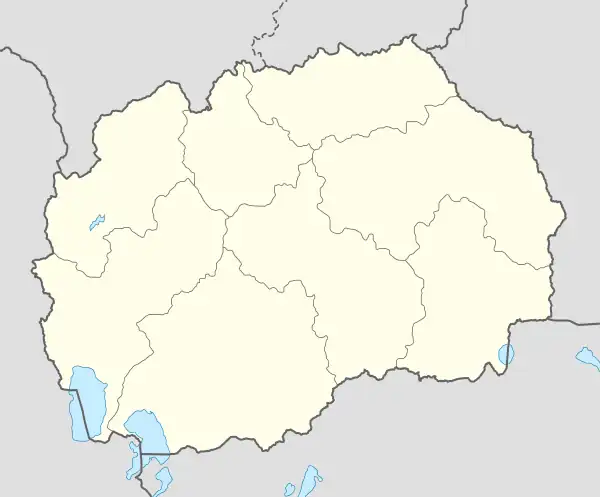Trebište
Требиште Trebisht | |
|---|---|
Village | |
 Panoramic view of the village Trebište | |
 Trebište Location within North Macedonia | |
| Coordinates: 41°37′N 20°35′E / 41.617°N 20.583°E | |
| Country | |
| Region | |
| Municipality | |
| Population (2002) | |
| • Total | 765 |
| Time zone | UTC+1 (CET) |
| • Summer (DST) | UTC+2 (CEST) |
| Car plates | GV |
| Website | . |
Trebište, Trebishte, or Trebišta (Macedonian: Требиште, Albanian: Trebisht) (the pronunciation used by the local population is Trebišča) is a village in North Macedonia in Mavrovo and Rostuša Municipality, situated in the Dolna Reka district, on the eastern slopes of Dešat, above the gorge of Radika.
History
In 1426 Albanian nobleman Gjon Kastrioti and his three sons (one being Skanderbeg) donated the right to the proceeds from taxes collected from the villages Rostuša and Trebište and from the church of Saint Mary, which was in one of them, to Hilandar.[1] In the Ottoman defter of 1467, the village of Trabishta is recorded as part of the ziamet of Reka which was under the authority of Karagöz Bey. The village had a total of 15 households and the anthroponymy recorded was overwhelmingly Slavic in character, although instances of Slavicisation are easily identifiable. For example, the patronymic Bukurovići is attested in three household heads and is derived from the Albanian bukur ("beautiful") and Slavic suffix -ovići, likewise, the patronymic Tanušovići is recorded and is derived from the Albanian personal name Tanush with the addition of the same Slavic suffix.[2] In 1519, 55 Christian Orthodox families were recorded in the village, while in 1583, the village had 41 Christian Orthodox families and 5 Muslim families.[3]
According to the 1942 Albanian census, Trebište was inhabited by 719 Muslim Albanians and 201 Bulgarians.[4]
Demographics
| Year[5] | Macedonian | Albanian | Turks | Romani | Vlachs | Serbs | Bosniaks | Others | Total |
|---|---|---|---|---|---|---|---|---|---|
| 1948 | 182 | 756 | ... | ... | ... | ... | ... | 2 | 940 |
| 1953 | 354 | 268 | 399 | ... | ... | ... | ... | 3 | 1024 |
| 1961 | 233 | 28 | 640 | ... | ... | ... | ... | 3 | 904 |
| 1971 | 379 | ... | 414 | ... | ... | ... | ... | 355 | 1148 |
| 1981 | 51 | 4 | 36 | ... | ... | ... | 1037 | 38 | 1166 |
| 1994 | 22 | 39 | 156 | ... | ... | ... | ... | 889 | 1106 |
| 2002 | 303 | 159 | 277 | ... | ... | ... | 18 | 8 | 765 |
| 2021 | 34 | 55 | 144 | ... | ... | ... | 19 | 245 | 498 |
Trebište has traditionally been inhabited by Orthodox Macedonians and a Torbeš population.[6]
According to the 2002 census, the village had a total of 765 inhabitants.[7] Ethnic groups in the village include:[7]
- Macedonians 303
- Turks 277
- Albanians 159
- Bosniaks 18
- Others 8
References
- ↑ Slijepčević, Đoko M. (1983). Srpsko-arbanaški odnosi kroz vekove sa posebnim osvrtom na novije vreme (in Serbian). Himelstir. p. 45. Retrieved 7 July 2011.
Заједно са синовима Константином, Репошем и Ђурђем приложио је Иван Кастриот манастиру Хиландару село Радосуше са црквом св. Богородице и село Требиште....Together with his sons Konstantin, Repoš and Đurađ, Ivan Kastriot donated village Radosuše with church of saint Mary and village Trebište to the monastery Hilandar...
- ↑ Caka, Eduart (2019). Defteri i hollësishëm për zonat e dibrës i vitit 1467. Tiranë: Akademia e studimeve albanologjike instituti historisë. p. 122.
- ↑ Dve povelje u Hilandaru o Ivanu Kastriotu i sinovima, Dušan Sindik
- ↑ http://pop-stat.mashke.org/alb-historic/1942-diber-tetove-ethnicrel-loc.htm
- ↑ Sherafedin Kaso (2005). The settlements with Muslim population in Macedonia. Logos-A. p. 339. ISBN 978-9989-58-155-7.
- ↑ Vidoeski, Božidar (1998). Dijalektite na makedonskiot jazik. Vol. 1. Makedonska akademija na naukite i umetnostite. ISBN 9789989649509. p. 214. "Заедно со македонско христијанско население Торбеши живеат и во селата: Могорче, Требиште, Велебрдо, Ростуше, Јанче, Долно Косоврасти (во Река),"
- 1 2 Macedonian Census (2002), Book 5 - Total population according to the Ethnic Affiliation, Mother Tongue and Religion, The State Statistical Office, Skopje, 2002, p. 168.